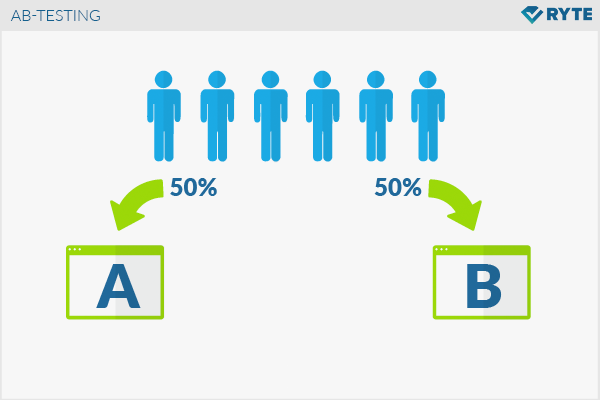AB-Testing
A/B testing gives webmasters a way to optimize their website bit by bit by comparing two website versions (A and B) and small adjustments get made each time. This is followed by analysis by profiling analytics, and the more promising version gets determined.
Application examples for A/B testing
A/B testing is used to measure the success of two different versions of a website. This can be applied in various areas.
Testing of a new web design
When a new template is being created, you can find out whether users prefer the new web design over the old version. The two different design versions are put online and tested, in terms of which version users like better.
Testing of improved features
If the user guidance and navigation has been updated or new features (such as filters, search function, purchase consultant, product comparison function) are being introduced, A/B split testing can be used to test them. Operational errors can also be detected and fixed.
Testing the conversion rate of landing pages
If a site operator is not sure whether a landing page exploits its maximum conversion potential, they can put another landing page online, which is built differently and thus find out which one brings in a higher conversion rate. The effect of images and videos, structuring of contact forms, the amount of text or special discounts can be tested with A/B testing.
How it works
If changes are made to a web page, it can immediately affect traffic. Both the length of stay and bounce rate can be dramatically affected. Since the statistics don’t always show a positive change, A/B testing allows for a gradual improvement, where success is always kept in mind.
When performing A/B testing, the incoming traffic is split and a portion of the stream of visitors is diverted from the original page and directed to a modified page. This splitting is carried out arbitrarily and without the user's knowledge. Finally you can assess whether version A or version B contributes to the desired success. Depending on the objective of the website operator, a success could be considered to be an increase in the conversion rate by clicking on a banner or subscribing to a newsletter.
Temporal factors
It is important in A/B testing that both versions are tested simultaneously, so that, for example, one visitor gets to see version A, the next visitor gets version B, and so on, alternately. If the versions are alternated hourly, daily, or after a specified number of visitors, there is a risk of falsification. How many visitors visit a web page and their willingness to buy, depends not only on the web page itself but also on external sources of interference. In terms of the exact time and day, there is a difference whether it is during the workweek or on the weekend, whether it is morning, afternoon or evening, and if the users have ended work for the day or are still working.
Benefits
- Any changes can be subjectively compared through A/B testing. The viewpoint of an individual person often differs from the overall view of the target group. When optimizing a website, the interests of the target group should be taken into account.
- Testing can be easily accomplished with suitable tools. The effort is minimal and requires no technical knowledge.
- The analysis of the test results is conclusive. The adjustment of the website can be carried out immediately after the A/B testing.
- This tool is also suitable for sites with only a few visitors a day.
Disadvantages
- A/B Testing is only useful if you can keep track of the changes. If multiple parts are tested, it is impossible to identify the actual cause for success in the analysis. A number of tests are required to make several improvements to a website.
- Since there will only be one winner in A/B testing and that will be the version that gets pursued further, half of the information is always lost automatically. If you test the next two versions, the question remains, how the conversion rate would have changed if the discarded version would have been adjusted based on the most recent test.
- Radical changes which are undone a short time later can confuse existing customers. Therefore, A/B testing should always be carried out only with new visitors.
- In order to gain really conclusive information, it should be statistically significant. That can take quite some time, especially for smaller websites with only a few visitors or conversions.
A/B testing providers
There are a variety of tool providers through which you can perform A/B testing:
- Optimizely: Easy to use system suitable for SMEs as well as for large companies with WYSIWYG editor and test results in real time, 30 day trial, then 14 Euros for up to 2,000 visitors ( Bronze), additional packages for higher needs
- Google Content Tests: free offer from Google (formerly Google Website Optimizer), part of Google Analytics, compared with other services, however, less intuitive facilities and fewer options
- Kameleoon: Easy installation within minutes, intuitive operation thanks to a WYSIWYG editor with simple or extended reporting, minimal loading times, Freemium account up to 2,500 visitors per month, payable packages QuickStart (up to 65,000 visitors), Standard (for 200,000 visitors), Premium (300,000 visitors).
- Visual Website Optimizer: Easy to use tool with WYSIWYG editor, numerous additional functions such as heat and click maps, easy installation, 30-day free trial up to 1,000 visitors, after that five packets between 10,000 and 300,000 visitors ($49 - $729)
In addition to that, there are more expensive solutions such as Adobe Omniture, HP Optimost or Sitespect, which could be useful for large companies.
Web Links
- Best Practices & Lessons Learned from 30,000 A/B and Multivariate Tests YouTube Video from Optimizely, 2012

